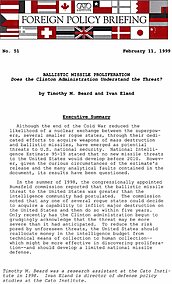In the summer of 1998, the congressionally appointed Rumsfeld commission reported that the ballistic missile threat to the United States was greater than the intelligence community had postulated. The commission noted that any one of several rogue states could decide to acquire a capability to inflict major destruction on the United States and then do so within five years. Only recently has the Clinton administration begun to grudgingly acknowledge that the threat may be more severe than it had anticipated. To reduce the risk posed by unforeseen threats, the United States should reallocate money in the intelligence budget from technical means of collection to human collection–which might be more effective in discovering proliferation–and should develop a limited national missile defense.
Ballistic Missile Proliferation: Does the Clinton Administration Understand the Threat?
Although the end of the Cold War reduced the likelihood of a nuclear exchange between the superpowers, several smaller rogue states, through their dedicated efforts to acquire weapons of mass destruction and ballistic missiles, have emerged as potential threats to U.S. national security. National Intelligence Estimate 95–19 stated that no new missile threats to the United States would develop before 2010. However, given the curious circumstances of the estimate’s release and the many analytical faults contained in the document, its results have been questioned.
About the Authors
Timothy M. Beard was a research assistant at the Cato Institute in 1998. Ivan Eland is director of defense policy studies at the Cato Institute.

This work is licensed under a Creative Commons Attribution-NonCommercial-ShareAlike 4.0 International License.
